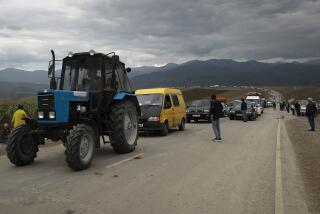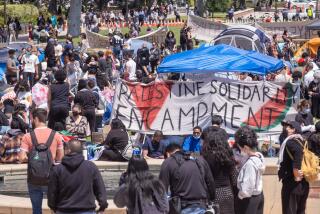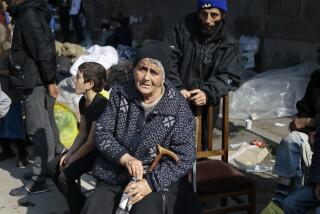Armenians Ride Cutting Edge for Reform, and That’s in Our Interest
Despite the extraordinary nature of the events over the past eight months in the Soviet republic of Armenia and the adjacent district of Nagorno-Karabakh, many Americans may ask, as did Ted Koppel on ABC-TV’s “Nightline,” “Why would Americans, other than Armenian-Americans, care?”
This question needs addressing.
Since Feb. 13 Armenians have held an unprecedented series of demonstrations, strikes and vigils ranging in size from a few thousand to nearly 1 million people. The Armenians are simultaneously affirming and testing Soviet leader Mikhail S. Gorbachev’s policies of glasnost and perestroika . At the same time, by demanding the unification of Nagorno-Karabakh with Soviet Armenia, they are also seeking to define for themselves the meaning of Gorbachev’s much-heralded but as yet undefined new nationalities policy.
We have watched as Gorbachev himself has met with representatives of the demonstrators, as the Soviets have ousted the party chiefs of Armenia and Azerbaijan, as troops and tanks have been deployed throughout the area, as the massacre of Armenians in the Azerbaijani city of Sumgait has been revealed, and as the most recent incidents of violence against Armenians in Azerbaijan have been reported by the media. Through it all the demonstrations continued--historic in size, consistent in purpose and surprising in restraint. And through it all we have witnessed growing Armenian disillusionment and anger with the indecisive and contradictory application of Gorbachev’s rhetoric. With each Soviet rejection of Armenian demands, the Armenians have responded with a renewed sense of purpose. The Armenians are now at the cutting edge of the Soviet peoples’ demands for fundamental reform--and, in the case of nationalities, for autonomy sufficient to define each people’s cultural, educational, environmental and economic future within the context of the Soviet state.
Yet Soviet hard-liners who are opposed to glasnost and perestroika have seized on the Armenian situation to undermine Gorbachev’s programs. Thus his continued ability to deal with the United States in the crucial areas of arms reduction and regional conflicts will depend in some measure on his ability to resolve the Armenian question and other nationality questions that were deferred and suppressed by his predecessors.
The United States has traditionally concerned itself with the plight of minorities throughout the world. Countless thousands of lives have been saved through American intercession. In the case of the Soviet Union, the United States has not hesitated to speak out on behalf of the rights of ethnic and religious minorities. For the past 65 years the Armenians of Nagorno-Karabakh have been a severely disadvantaged minority under jurisdiction of Azerbaijan. Armenian cultural and religious institutions have been proscribed, and the economy has been deliberately underdeveloped. The intent of these policies has apparently been to encourage Armenian flight. But the Armenians have stubbornly remained, and, sensing in Gorbachev a man genuinely committed to reform and to confronting past injustices, have stepped forward to demand a solution. The United States should support this quest for human rights as it has done elsewhere.
The American government and public have a historic relationship with the Armenian people, whose existence in the 20th Century has been difficult and tragic. The massacres of Armenians in the Turkish Empire at the turn of the century were followed by genocide during World War I. The Armenian provinces were depopulated, resulting in the end of a 3,000-year presence in most of the historic homeland. The survivors were scattered throughout the world.
Attempts to create an independent Armenian republic after World War I were quashed by the armed opposition of the Turkish nationalists and the hostility of Soviet leaders headed by Josef Stalin. The remaining territory became a Soviet republic, but with Armenian Nagorno-Karabakh ceded to Azerbaijan in order to cement Soviet-Turkish relations.
Since the first reports of Armenian massacres at the turn of the century, the United States led the diplomatic and humanitarian efforts to end the carnage. President Woodrow Wilson went so far as to propose that the United States assume a protective mandate over Armenia. The fate of the Armenians was a priority humanitarian and political concern. In that tradition, once again the United States should express its support for the simple right of the Armenians of Nagorno-Karabakh to join with their kinsmen in the Armenian republic, less than 10 miles distant.
The Armenians, and all other groups on parallel paths within the Soviet state, require not the West’s intervention but consistent acknowledgment and vigilance. Should the reformers succeed, the Soviet Union could become a more predictable and humane global competitor. Should they fail, the Soviet Union will revert to form--a hostile superpower with a siege mentality.
Independent and regardless of the reaction in the United States and the West, the Armenians will persevere. They have the inalienable right to do so. They have the human right to succeed.
More to Read
Sign up for Essential California
The most important California stories and recommendations in your inbox every morning.
You may occasionally receive promotional content from the Los Angeles Times.










